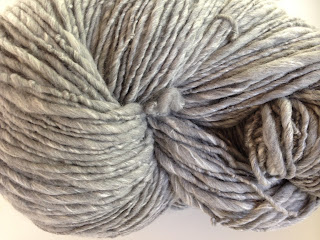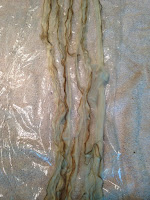Fingerless Glove Pattern
Notes about my handspun art yarns:
Most of my yarn have dimensional design elements. These elements are best displayed on the front of knitted work by either purling or putting the design element to the front of the work and then knitting the next bit of yarn through the back of the stitch. This way all the design elements will easily pop to the front of the finished work.
Always make a swatch of combined yarns before committing to project.
Materials:
(estimated minimum yardage)
18yds chunky dimensional yarn (cuffs)
40yds thick n thin (glove body)
Needle size:
US9, US10 DPNs depending on your gauge
Stitch notes:
M1 - my increase preference for thumb gussets is to lift the left leg from the stitch below the last knit stitch (right needle) and place it on my left needle so it looks like a new knit stitch. Another way to say this is that I insert my left needle from the front to the back into the left leg of the stitch below the last stitch I knit (right needle). Then I knit it.
Bind Off Purlwise - I like to purl the first stitch, make a loop on my right needle, purl the next stitch. Pass the first stitch and new loop over this last stitch made on the right needle. *Make a loop, purl the next stitch, pass the first stitch and new loop over the last stitch.* Continue with ** until you reach the end. Join in the round. Cut yarn leaving a 6” tail.
Begin:
With chunky dimensional yarn, cast on 18 stitches using your preferred method. Divide stitches evenly onto 3 DPNs and join in the round.
Cuff: Knit several K1, P1 rounds with knit stitches being knit through the back loop. Make the cuff as deep as you like.
Body: Change yarn to thick n thin yarn and knit 4 rounds. Begin increasing for the thumb gusset as follows: K3, M1, knit until the last 3 stitches, M1, K3. Knit next round. Repeat these two rounds until you have 10 stitches on #1 and #3 DPN. Continue knitting 4 or 5 rounds or until your work reaches just above the base of your thumb (you will need to try on your work in progress). Knit next round until the last 4 stitches, place last 4 stitches onto new DPN. Place additional 4 stitches from #1 DPN onto new DPN. There are now 8 stitches on new DPN for your thumb. Using I-cord method knit at least 2 rounds on thumb then bind off purlwise (see Bind Off Purlwise notes above). A ladder of unknit stitches will have formed on the thumb. Thread the 6” tail on to a tapestry needle and weave the tail down to the base of the thumb. WIth a crochet hook loop the tail and catch one bar/rung at a time to close this gap. The thumb base will be tidied up when you weave in the ends. Continue knitting the body of the glove until you reach the desired length (try on your work in progress). Bind off purlwise.
Weave in your ends taking special attention at the thumb/body intersection.






























